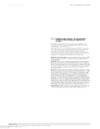Identificador persistente para citar o vincular este elemento:
https://accedacris.ulpgc.es/jspui/handle/10553/41336
| Título: | Diagnostic usefulness of the protein energy wasting criteria in prevalent hemodialysis patients | Autores/as: | Anton, Gloria Santana-del-Pino, Angelo Henriquez, Fernando Monzon, Tania Sanchez, Ana Yurena Valga, Francisco Morales, Adelaida Garcia, Cesar Rodriguez, Jose Carlos Carrero, Juan Jesus |
Clasificación UNESCO: | 320506 Nefrología 240401 Bioestadística 120903 Análisis de datos |
Palabras clave: | Hemodialysis Cachexia Diagnosis |
Fecha de publicación: | 2018 | Publicación seriada: | Nephrology Dialysis Transplantation | Conferencia: | 55th Congress of the European-Renal-Association (ERA) and European-Dialysis-and-Transplantation-Association (EDTA) | Resumen: | INTRODUCTION AND AIMS: It is unknown whether the criteria proposed to define the Protein Energy Wasting (PEW) syndrome have diagnostic validity in patients undergoing dialysis. METHODS: Prospective cross-sectional study including 468 prevalent hemodialysis patients from Canary Islands, Spain. Individual PEW syndrome criteria and the number of PEW syndrome categories were related to other objective markers of PEW using linear and logistic regression analyses: subjective global assessment (SGA), handgrip strength, bioimpedance-assessed body composition and levels of high-sensitivity C-reactive protein (CRP). RESULTS: Study participants (34% women) had a median age of 66 years, 37 months of maintenance dialysis and 50% were diabetics. 23% of patients had PEW (>=3 PEW criteria), and 68% were at risk of PEW (1-2 PEW criteria). Low prealbumin was the most frequently found derangement (52% of cases), followed by low albumin (46%), and low protein intake (35%). Across higher number of PEW syndrome criteria, patients showed a longer dialysis vintage and had lower creatinine, triglycerides and transferrin (P for trend <0.001 for all). All nutritional assessments not included in the PEW definition worsened across higher number of PEW categories. In multivariable regression analyses, there was a linear inverse relationship between muscle and fat mass as well as handgrip strength with the number of PEW syndrome categories. Likewise, the proportion of SGA-defined malnutrition and serum concentration of CRP gradually increased despite adjustment for confounders (P for trend <0.05 for all). CONCLUSIONS: The PEW criteria reflect systemic inflammation, malnutrition and wasting among dialysis patients, and may thus be used for diagnostic purposes. | URI: | https://accedacris.ulpgc.es/handle/10553/41336 | ISSN: | 0931-0509 | DOI: | 10.1093/ndt/gfy104.SP654 | Fuente: | Nephrology Dialysis Transplantation[ISSN 0931-0509],v. 33 sup. 1, Abstract SP654, (Mayo 2018) |
| Colección: | Artículos |
Visitas
152
actualizado el 15-ene-2026
Descargas
101
actualizado el 15-ene-2026
Google ScholarTM
Verifica
Altmetric
Comparte
Exporta metadatos
Los elementos en ULPGC accedaCRIS están protegidos por derechos de autor con todos los derechos reservados, a menos que se indique lo contrario.
